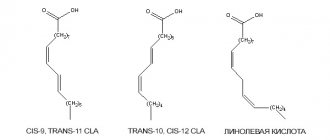Fats are an important nutritional component in many foods. They have the highest energy value. And for many of us, it is also a key component of subcutaneous fatty tissue, which, with its thickness, stimulates us to exercise and a healthy lifestyle. Excess fat in food spoils our figure and provokes atherosclerosis and other cardiovascular diseases. The deficiency is no less dangerous, because of it the level of sex hormones drops, muscles atrophy, the skin becomes flabby and the nervous system suffers. How to be? Try your best to get rid of fat, declare war on it, or accept the inevitable? Let's try to figure it out.
What are fats?
Let's mentally return to our school desk (just for a second) and remember that from a chemical point of view, fats belong to the class of triglycerides. This is important for us only in order to understand how these paradoxical substances work. They are based on the well-known glycerin, which is the simplest trihydric alcohol - it has a hydroxyl group (-OH) attached to each carbon atom (there are 3 of them in glycerol). For comparison, ordinary ethyl alcohol has 2 carbon atoms in its molecule and only one of them has an OH hydroxyl group attached. So, if you remove a hydrogen atom from each alcohol (hydroxyl) group of glycerol and instead add the remainder of some carboxylic acid (oleic, stearic, palmitic, etc.), then you will get a triglyceride molecule, i.e. . fat And these same carboxylic acids are also called fatty acids (precisely because they are part of fats).
Why does the body retain water?
Our body stores carbohydrates to get energy from them as quickly as possible. They retain water. When a person goes on a diet, it is these reserves that are burned first - it comes to fat later. Consequently, a lot of water is lost.
In any case, water is stored again as soon as the loser begins to eat enough carbohydrates again to replenish their supply. This is partly what the myth of the yo-yo effect is based on.
Real weight loss can only be tracked by weighing yourself regularly and consistently, rather than doing it periodically. After a day of binge eating, it's easy for the scale to tip off, simply because the body has used more water than usual due to hormonal surges or other reasons. Or vice versa. One day, if considered separately from the rest, means nothing.
Properties of fats
Actually, the properties of fats are determined by the structure of these fatty acid molecules that make up them. But here the situation is a little more complicated. Approximately 90% of all fats consist of 3-4 fatty acids (just the ones we mentioned above). If the fat contains more stearic and palmitic acids, then these are saturated fats and they are solid at normal temperatures (20 degrees Celsius). If there is more oleic and other unsaturated acids (linoleic, linolenic, arachidonic, etc.) then these are unsaturated fats; they are liquid at normal temperatures.
All fats we are familiar with are insoluble in water. Under certain conditions, they can form an emulsion (a suspension of tiny droplets in water). A typical example is milk. Fats themselves can act as a solvent - for example, water-insoluble vitamins (A, D, E) are often dissolved in natural fats. Thanks to this, they enter our body along with fats.
How much weight do daily water fluctuations add to us?
Most of the human body consists of water and can store several liters in a couple of hours. The usual daily weight fluctuations due to water are three kilograms, plus or minus. In some rare cases it reaches five.
One kilogram of fat is formed when the body receives 7,000 “free” calories. An average weight person burns about 2,000 calories a day and if he reduces his intake to 1,000, he will lose about 140 grams per day. The result will be a weight loss of one kilogram per week.
The problem is that this amount of weight is easily covered by the natural fluctuations of the water. So a woman can eat almost nothing for three days, lose half a kilo of fat, but still store some water. When she steps on the scale, she will think: “What?!” I fasted for three days and gained half a kilo?!”
On the other hand, people often lose several kilograms very quickly at the beginning of a diet, precisely because excess water is lost.
Why do we need fats in the body?
A natural question arises: why do we need all this organic chemistry? What, you can’t live without her? Unfortunately no. Fats play an important role in our metabolism and even more than one. Their functions can be briefly summarized as follows:
- structural - fats are part of cell membranes,
- thermoregulatory - subcutaneous fat is an excellent heat insulator, it is not cold,
- protective - our internal organs are surrounded by a layer of visceral fat, which protects them from damage, displacement, shock, etc.,
- energy - the body extracts energy from fats, which is required for all processes without exception,
- storage - adipose tissue stores not only energy reserves, but also other necessary substances: vitamins, large amounts of water, minerals.
The energy content of fats is colossal - approx. 9.3 kcal/g. That is, the energy released during the processing of 1 g of fat is enough to lift a load of 2 tons to a height of 2 meters. And 100 kg of fat is enough to send a 65 kg rocket into space.
Fats are involved in the absorption of the so-called. fat-soluble vitamins (A, D, E). It is the content of vitamins and some other substances that determines the value of fatty products such as fish oil.
In addition, fats are required for the secretion of a large number of hormones: including testosterone, estrogens, cortisol, etc. From this alone it is clear that fats cannot be completely excluded from the diet - without them the hormonal system will suffer. Their amount in food should not be less than 10-15%.
So to burn fat you just need to breathe more often?
For example, on average a person weighing 70 kg at rest takes 12 inhalations/exhalations in 1 minute, exhaling approximately 200 ml of carbon dioxide (CO2), the density of CO2 is 1.97, it turns out that on average a person at rest exhales 369 mg per minute carbon dioxide.
Here are the average metabolic rates for a person weighing 68 kg. Source: Wen-Jei Yang Biothermal-fluid Sciences: Principles and Applications 1989
It turns out that per day we exhale from 0.5 kg of carbon dioxide to 0.7 kg of carbon dioxide, depending on the degree of our physical activity. So exhaling 8.4 kg of carbon dioxide is not that difficult, it will take 12-17 days.
Animal and vegetable fats
Fats obtained from plant or animal foods differ in their composition and properties. Animal fats (beef, pork, lamb, etc., as well as butter), also called “lard,” are usually solid - we have already said that this is due to the high percentage of stearic and palmitic acids in their composition. They are difficult to break down by the body and are absorbed by only 20-30%.
Vegetable fats are more diverse in composition, but they are united by the fact that the proportion of saturated fatty acids in their composition is minimal, so they not only exist in liquid form, but are also easily absorbed by the body. Vegetable fats (also called oils) are unsaturated, which means that their molecules contain double chemical bonds. They are more unstable and easily ruptured, causing unsaturated fats to enter into biochemical reactions (for example, oxidation). Because of this, our body likes vegetable fats more - it can more easily obtain energy from them, and besides, it is unsaturated fats (omega-3 groups) that are required for the construction of cell membranes.
Both animal and vegetable fats are needed by the body; in no case should they be completely excluded from the diet, as we have already said. Even when losing weight.
Example - how important a balanced diet is
Imagine a woman who really wants to lose weight, but is smart enough not to fall into the typical scenario. For six months she consumes 500 calories a day, constantly monitoring her condition through tests and taking vitamins. Gradually, her health improves so much that she begins to do exercises: strength training and an exercise bike.
She is losing weight constantly and quite radically, burning 500 calories a day and thinking that now her weight loss will accelerate even more. Amazing! And in the first few days everything is really like that. But then the weight loss begins to level off. Over the course of a year, the resulting weight loss graph looks like this:
- At the start of the exercise program, April 19, the weight is 107.3 kg. Over the next four days it drops to 105.2. Of course, 2 kilograms in such a time is too much, and at least half is water. However, a woman expects to lose weight about as quickly.
- On May 9, the weight is 105.3 kg, even though more than two weeks have passed, she still eats 500 calories a day, and does an hour of exercise every day.
At this point, you might give up, telling yourself that your body must have gone into starvation mode if you can't lose weight even with such a strict program. But the woman does not give up and goes to the doctor for a referral for a blood test.
The result shows that the exercise program has increased the body's need for protein and 500 calories are no longer enough to meet the increased needs. Meanwhile, she feels worse: she suffers from weakness, poor circulation and hair loss. This only lasts about two weeks, but the symptoms are very frightening: the hair remains in the comb, the skin is dry and pale, it is difficult to get out of bed.
This is a clear illustration of how nutritional deficiencies affect the body and how important it is to eat a balanced diet that contains all the essential nutrients.
Together with her doctor, the woman decides to double her calorie intake and make sure she includes 150 grams of protein per day. Over the next few weeks, the remaining fluid slowly drains away, and she loses a lot of weight - so much so that on May 18 she already weighs 100 kilograms
. That is, in 9 days she lost 5.3 kg at once! The symptoms also go away quickly, the state of health improves, and the weakness disappears.
The above graph shows that weight was lost constantly and exactly as normal, but daily fluctuations of 1 to 2 kg occurred constantly. It also shows that there were periods of several days without weight loss and even some weight gain, although caloric intake was maintained constant and very low.
This is an important discovery: it would be a mistake to assume that you can quickly lose a few kilograms by not eating anything for several days. In reality, these kilograms will be just water, which the body will again store as soon as the opportunity arises.
A person needs about 2000 calories per day, and if you eat nothing, then only 280 grams of fat will be lost in a whole day. Even if the scale shows a short-term plummet of 2 kilograms, the actual weight loss will be only a little more than one tenth of this number.
Pay serious attention to this factor and lose excess weight, taking into account daily fluctuations in water in the body, without giving up or returning to previous positions!
Healthy and harmful fats for the body
It is believed that excess animal fats in food increases harmful cholesterol in the blood and is one of the important factors of atherosclerosis. Today this point of view is disputed by many experts. The fact remains: when microdamages appear in the walls of blood vessels, cholesterol molecules begin to accumulate in these places, as if covering up the damaged areas. Cholesterol deposits are formed, under which the walls of blood vessels degrade even more, and the lumen of the vessel narrows due to cholesterol deposits, impairing blood flow and oxygen supply to tissues, which leads to coronary heart disease, strokes and other tragic events. The question of what came first - damage to the walls of blood vessels or cholesterol deposits - is still being debated, but it is quite clear that cholesterol brings not only harm, but also benefit.
Harmful fats are generally believed to be saturated animal fats. But it is important to consider that it is not the properties of these substances themselves that make them harmful, but their excessive consumption. If you eat a lot of fatty meat and lard, the fat will harm the body. If you do not overuse lard and fatty lamb, then even animal fats will bring more benefit to the body than harm. Of course, only overcooked fats are harmful. At high temperatures (190 degrees Celsius), fats quickly oxidize and some of them break down into toxic substances. Accordingly, the higher the temperature and the longer you fry something, the more harmful the fat becomes. You should absolutely not eat fat from frying or even reuse it for frying.
One way or another, vegetable fats are considered to be more healthy; it is also recommended that they make up at least half of the total share of dietary fats. The most common vegetable fats found in nature are omega-9 unsaturated fats: oleic acid, which makes up 90% of olive oil, and is also present in large quantities in sunflower and other common vegetable oils.
And the healthiest fats are unsaturated fats from the omega-3 group. There is a lot of alpha-linolenic acid in flaxseed oil. And some omega-3 (eicosapentaenoic and docosahexaenoic acids) are present almost exclusively in fish oils, which is why it (although technically it refers to animal products) is extremely useful and is considered an important means of preventing cardiovascular diseases, and is indispensable for brain growth and development in children.
So, healthy fats include unsaturated fats omega-3 (fish oil, flaxseed oil), omega-6 (nut oils, safflower, flaxseed, canola), omega-9 (olive oil). But for those who can't get enough unsaturated fats from regular foods, there are special dietary supplements that contain healthy fats.
What affects changes in the amount of fluid in the body?
Slight fluctuations in the amount of fluid can be caused by the following reasons:
- features of the drinking regime - it may seem strange, but the less you drink, the more the body stores;
- temperature - when it’s hot, people’s arms and legs often swell;
- hormones - many women suffer from swelling before menstruation (associated symptoms often occur: the breasts swell and become sensitive, gases appear, and so on);
- physical activity - often because of it, micro-tears appear in the muscles, which can cause swelling;
- high salt consumption - if a person eats salty food, he will suffer from edema for some time;
- sweating - baths and intense physical activity can cause dehydration and, accordingly, sudden and rapid weight loss (up to several kilograms).
Large fluctuations in the amount of fluid in the body are usually caused by other reasons. These include:
- taking medications that affect the hormonal system, such as oral contraceptives or cortisone;
- certain medical conditions such as hypothyroidism (if left untreated);
- lack of nutrients such as protein or vitamins;
- food allergies or food intolerances.
Healthy fats for women
Fats can bring a lot of benefits to the fair sex. And we won’t even talk about the use of fats as cosmetic procedures, in which various oils and fats are constantly present. Let's consider only the benefits of ingestion.
- Healthy fats help you lose weight. Yes, paradoxically, unsaturated fats (especially omega-3) stimulate fat metabolism, accelerate the processing of fats in the body and thus activate weight loss.
- Fats support the secretion of hormones, incl. estrogens. As we know, the result of low estrogen levels is such unpleasant things as sagging skin, mood swings, sleep disturbances, osteoporosis (weakening bones).
- Vitamins enter the body with fats: A protects vision, D supports immunity and calcium balance in bones, E – health of the reproductive system. If there is a lack of fat, vitamin deficiency with all the accompanying troubles is likely to occur.
We have already said which fats are most beneficial (including for women), but let us remind you: these are unsaturated fats of the omega-3 group (fish oil and flaxseed oil), and to a lesser extent omega-6 and omega-9.
Fats in food are not always present in sufficient quantities and in good quality. Not every fatty fish is rich in unsaturated omega-3 fats - they break down very easily at high temperatures and in light. Therefore, if you want to supplement your diet with healthy fats, it is better to purchase appropriate supplements, and it is better to choose them in capsules rather than in bottles - capsules better preserve unsaturated fats.
How to distinguish - swelling or excess fat?
One way to determine whether the cause of excess weight is water or fat is to look for red marks from swelling on the skin, for example, in the waist area under the belt of your trousers or on the ankles under the elastic bands of your socks. If there is a lot of excess fluid in the body, there will be traces.
Also a sign of edema is a sharp increase in weight: even if a person eats twice his daily allowance, he will not gain more than 300 grams per day. Therefore, if you gain a few kilograms in a week, but eat about the same as always, most likely the cause is swelling.
If swelling appears suddenly, you should urgently consult a doctor: he will check whether it is caused by an illness or a lack of nutrients. It is better to refrain from self-medication, since neither diuretics nor weight loss products will remove the cause.
Electronic scales and hand testers
Relatively recently, another way to measure the amount of fat has appeared - electronic scales and hand-held testers. The most popular scales are Tanita. The most popular hand-held testers are made by Omron. Both scales and testers also work using the bioelectric method.
Manufacturers provide all the necessary information about the testing process and the results of determining body composition using scales and testers. But most of these tests were done in a laboratory using the usual method, that is, using electrodes on the wrists and legs. We cannot use these documents in relation to testers and scales, as they do not measure the percentage of fat in the entire body, but only in part of it. Although it should be noted that recently scales have appeared with additional handles for passing current through the entire body.
The advantage of using scales is the possibility of self-testing at home. However, this type of measurement is less accurate than laboratory measurements. If you decide to use this particular method, then do not forget that all measurements must be taken at the same time of day.









